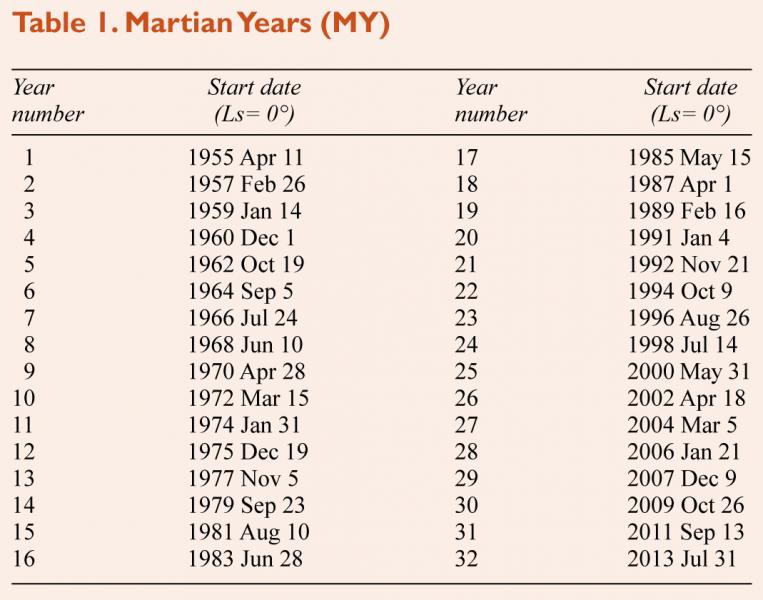The opposition of Mars, 2012: Part I
2019 October 2
Introduction
 In this report we adopt the convention of numbering Martian Years (MY), beginning at the 1955–’56–’57 apparition at the dawn of the Space Age. Each year begins at Northern Spring Equinox, at Ls (areocentric longitude)= 0°. Table 1, from Meeus (1983), lists the first 32 Martian Years.
In this report we adopt the convention of numbering Martian Years (MY), beginning at the 1955–’56–’57 apparition at the dawn of the Space Age. Each year begins at Northern Spring Equinox, at Ls (areocentric longitude)= 0°. Table 1, from Meeus (1983), lists the first 32 Martian Years.
Third in the present series of aphelic encounters, Mars was undergoing late northern spring at opposition on 2012 Mar 3 at Ls= 78°, when it was very close to aphelion (Ls= 70°). The planet lay in Leo with a relatively favourable declination for European observers of +10° that did not unduly disadvantage our Australian contributors. The latitude of the sub-Earth point (or disk centre), De, varied from –20° in 2011 mid-May, falling to zero in late July and rising to nearly +24° in December. It remained high at +22° at opposition, rising further to +26° in 2012 June and decreasing to zero in November.
Mars was closest on 2012 Mar 5, at 101 million km, with a disk diameter (D) of 13.9″; almost the least possible at opposition, and the smallest of the current cycle. D remained above 6″ from 2011 Nov 3 till 2012 Jul 20. Key seasonal dates are given in Table 2. Observing conditions in the UK were typical, but the weather deteriorated considerably after opposition. 110 contributors sent 5,226 images and 724 drawings; 5,950 observations covering 2011 May 12 (Ls= 291°, D= 4.1″ (Akutsu image)) to 2013 Feb 14 (Ls= 264°, D= 4.0″ (Adamoli drawing)). Days per month logged (actual/possible) were: 2011 May, 2/31; June, 3/30; July, 12/31; August, 24/31; September, 28/30; October, 25/31; November, 23/30; December, 27/31; 2012 January, 29/31; February, 29/29; March, 31/31; April, 30/30; May, 31/31; June, 22/30; July, 20/31; August, 10/31; September, 2/30; 2012 October, 0/31; November, 0/30; December, 0/31; 2013 January, 2/31 and 2013 February, 4/28.
We covered 92% of the span of a martian year (albeit fragmentary 2012 post-September), during MY 30–31. Akutsu, Maxson, Morales Rivera, Morita, Peach and Willems each took more than 150 images, with Maxson securing 647 on 156 dates (including much early morning work), and Willems (a new contributor) sending 678. I. D. Sharp obtained images from Barbados during 2011 December. Abel, Adachi, Adamoli, Bailey, Beish, Konnai, McKim, Macsymowicz and Niechoy each made more than 30 drawings. The most successful colour imaging was done by compositing individual red (R), green (G) and blue (B) filter images. Some observers display individual channels separated from a one-shot colour image, but ‘blue’ channel separations are misleading and useless as they encompass a much wider waveband than any ‘blue’ filter…. (continued)
(Login or click above to view the full illustrated article in PDF format)
| The British Astronomical Association supports amateur astronomers around the UK and the rest of the world. Find out more about the BAA or join us. |
